常耀信美国文学的学习课件
美国文学简史-序言-introductionPPT课件

of literature.
-
6
Basic Qualities of American Writers
1) Independent
2) Individualistic
3) Critical
4) Innovative
5) Humorous
-
7
Part II. The periods of American literature
II. American Prose Since 1945: Realism and Experimentation.
-
17
• Literature is characterized by beauty of expression and form and by universality of intellectual and emotional appeal.
2. Forms (genres) of literature? Poetry, novel (fiction), drama, prose, essay, epic, elegy, short story, journalism, sermon, (auto) biography, travel accounts, novelette, etc.
2) Thematic Approach
➢ “What is the story, the poem, the play or the essay about?”
3) Historical Approach
➢ Aims at illustrating the historical development
1) Modern poetry: experiments in form (Imagism)
美国文学简史常耀信版讲义6-The Writers of the “Lost Generation”
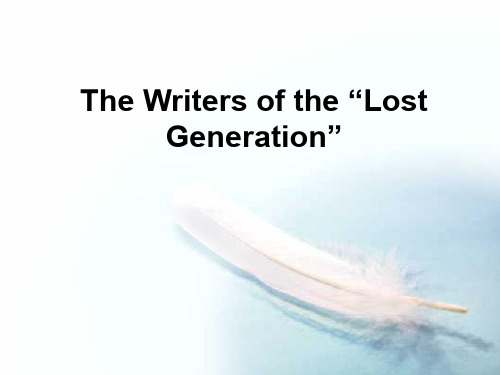
F. Scott Fitzgerald
• Dropped out of Princeton University in 1917 to fight in WWI, but the war ended before he shipped out. • one of the most popular and accomplished writers of the movement. • major works
This Side of Paradise The Last Tycoon
The Beautiful and the Damned The Great Gatsby
About The Great Gatsby:
The setting is New York City and Long Island during the 1920s. Nick, the narrator, is a young Princeton man, who works as a bond broker in Manhattan. He becomes involved in the life of his neighbor at Long Island , Jay Gatsby, shady and mysterious financier, who is entertaining hundreds of guests at lavish parties.
Montparnasse
Montparnasse served as the heart of artistic creativity and intellect in Paris after the war. Contained many cheap studios, apartments, and was also an area filled with important cafes and other nightlife. All of the Lost Generation writers found themselves here at one time or another.
英语专业考研_常耀信版_美国文学简史_课件_William_Faulkner1
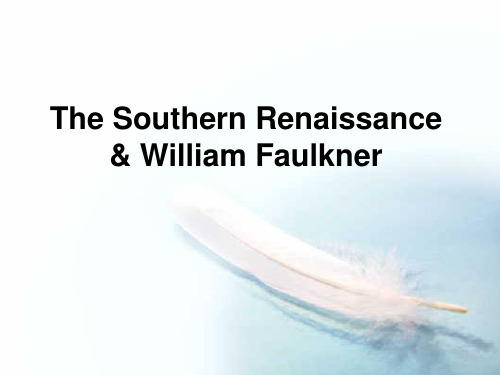
literary career: three stages
(1) 1924~1929: training as a writer The Marble Faun 《大理石雕像》
Soldier’s Pay 《士兵的报酬》
Mosquitoes《蚊群》 (2) 1929~1936: most productive and prolific period Sartoris 《萨托里斯》 The Sound and the Fury 《喧哗与骚动》 As I Lay Dying 《在我弥留之际》 Light in August 《八月之光》
爱米丽的玫瑰》、《红 叶》、《夕阳》和《干 燥的九月》
Yoknapatawpha 约克纳帕塔法
Yoknapatawpha County: --- A county in northern Mississippi, the setting for most of William Faulkner’s novels and short stories, and patterned upon Faulkner’s actual home in Lafayette County, Mississippi.
Faulkner in Hollywood
In the university of Virginia campus
William Faulkner: Nobel Prize Acceptance Speech
--- I feel that this award was not made to me as a man, but to my work -- a life's work in the agony and sweat of the human spirit, not for glory and least of all for profit, but to create out of the materials of the human spirit something which did not exist before. ---我感觉,这个奖不是授予我这个人,而是授予我的工作, 它是对我呕心沥血、毕生从事的人类精神探索的工作的肯定。 我的这项工作不为名,更不图利,而是要从人类精神的原始 素材里创造出前所未有的东西。
美国文学简史常耀信版讲义7
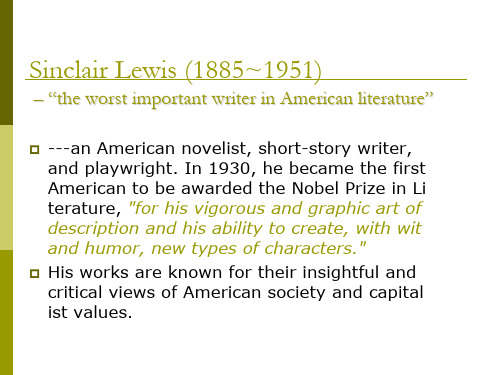
My Antonia
In the novel, he looks back on the course of events that shaped her life and made h er the woman she is. It is a story of Nebraska, celebrated the la nd and the immigrant pioneers, and linked the enduring figure of Antonia to the life fo rce itself.
Willa Cather 薇拉· 凯瑟
1873~1947
"Restlessness such as ours, suc cess such as ours, striving such as ours, do not make for beauty. Other things must come first, go od cookery, cottages that are ho me, not playthings; gardens, rep ose." 21 Droduction
Her fiction is unique in its powerful repres entation of setting and character and rich i n its language and imagery. Her style of w riting is condensed and subtle, but noneth eless tremendously expressive. A quote:
Sinclair Lewis
style (1)photographic,verisimilitude (2) colloquialism (3) characterization: he often created a type of character rathe r than an individual (4) old fashioned in theme (5) lack in psychological exploration
《美国文学》课件一
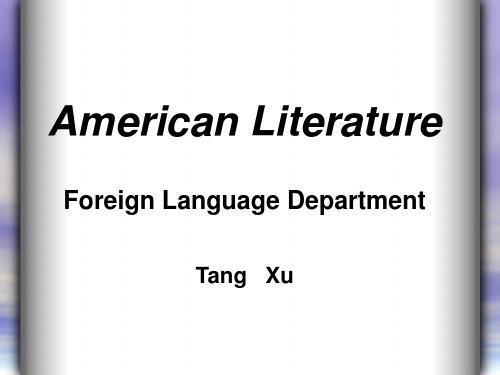
V. The Survey of Selected Readings in American Literature
• 2. Henry David Thoreau (1817-1862) was at first a faithful follower of Emerson, but alienated himself somewhat from the master later on. • 3. Another of Emerson's contemporaries, Walt Whitman (1819-1892), tried to write poetry describing the native American experience. • 4. Whitman and Dickinson were the two major American poets of the nineteenth century.
批注本地保存成功开通会员云端永久保存去开通
American Literature
Foreign Language Department
Tangmerican Literature
美国文学 PPT课件

Benjamin Franklin Philip Freneau
➢ Chapter III American Romanticism
Washington Irving James Fenimore Cooper William Cullen Bryant Edgar Allan Poe Nathaniel Hawthorne
Brief Outline of American literature
1. Colonial period (1607-1775)
Anne Bradstreet Edward Taylor
2. Revolutionary period
(1775-1783) Benjamin Franklin Philip Freneau
The early settlers
❖ Christopher Columbus discovered the American continent in 1492.
❖ Captain John Smith reached Jamestown, Virginia in 1607.
❖ Puritans came the New England area, by Mayflower in 1620.
❖ Literature is characterized by beauty of expression and form and by universality of intellectual and emotional appeal.
2. Forms (genres) of literature? Poetry, novel (fiction), drama, prose, essay, epic, elegy, short story, journalism, ts, novelette, etc.
常耀信美国文学史第三版Chapter 6 Whitman·Dickinson
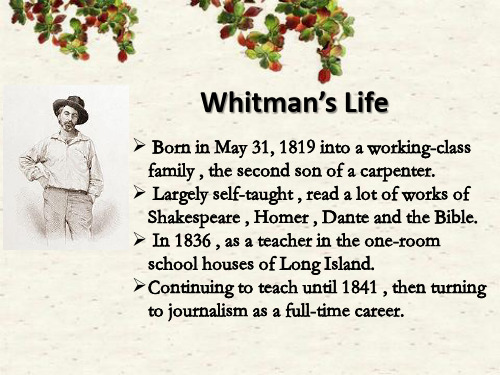
First edition(1855)
It contained twelve poems and did not sell well, but it made a stir on the American literary scene. It broke with the poetic convention, and its sexuality and exotic and vulgar language brought harsh criticisms on it.
➢In 1848, he traveled south to work in the New Orleans.
➢In 1855, the first edition of his work, Leaves of Grass came out with his own money, which contained twelve poems.
ideas about death, and beauty of death. ❖ Attacks the slavery system and racial
discrimination.
Literary points of view
❖Whitman was a catalog of American and European thought.
The Leaves were called “noxious weeds ,” it’s poetry “poetry of barbarism ” and “a mass of stupid filth.” 邪恶的种子,野蛮的诗歌,一滩愚蠢的污 秽物。
Whitman’s Major Works
❖ Responds enthusiastically to the expansion of America.
常耀信美国文学讲义PPT课件
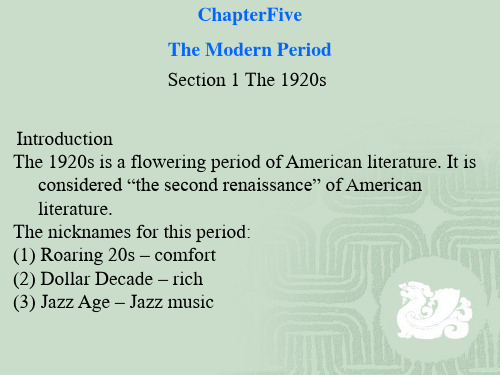
After this rough beginning, Robert went
on to become a great poet. He married Elinor White and had 2 kids. Robert never in truth had any jobs, except being a poet, but he published many poems in his lifetime. Robert won four Pultizer awards and read The Gift Outright (全心的奉献)at the inauguration of John. F. Kennedy. He died on January 29, 1963 of a heart attack. He was 88 years old.
Birches After Apple-Picking Stopping by Woods on a Snowy Evening The Road Not Taken
Frost's poems are
critiqued in the "Anthology of Modern American Poetry", Oxford University Press, where it is mentioned that behind a sometimes charmingly familiar and rural façade, Frost's poetry frequently presents pessimistic and menacing undertones which often are not recognized nor analyzed.
英语专业美国文学课件History of American Literature part 1

And Selected Readings
Marcus Cunliffe, The Literature of the United States Robert Spiller, The Cycle of American Literature Rod W. Horton and Herbert W. Edward, Backgrounds of American Literary Thought 常耀信,美国文学简史 常耀信,美国文学选读 童明,美国文学史 5.Rubinstein, Annette. American Literature, Root and Flowering(《美国文学的源和流》 6.史志康主编,《美国文学背景概观》 7.刘海平、王守仁等 “It is worth reiterating that those who colonized America during the 17th and the 18th centuries were part of a great migration initiated not only from all parts of England but also from Africa, from the Scottish Highlands, Ireland, Germany, Switzerland and other regions in Europe. While some of the settlers came in response to economic forces, others came in search for political and religious freedom. Africans were forced to come as slaves. This diversity of situations, when blended into specific environments, contributed to the development of regional cultures and to the cultural pluralism of America.” New England, Puritan literature: journals (diaries), hymns, sermons, home letters, histories; the South, Virginia: promotional tracts, journals, poems, letters, sermons (satire, a spirit of exploration inherent in the Renaissance); the Middle Colonies, culturally and ethnically more diverse: better reflecting the diversity of colonial life and anticipating the pluralism of America
美国文学简史常耀信版Chapter_4_Transcendentlism
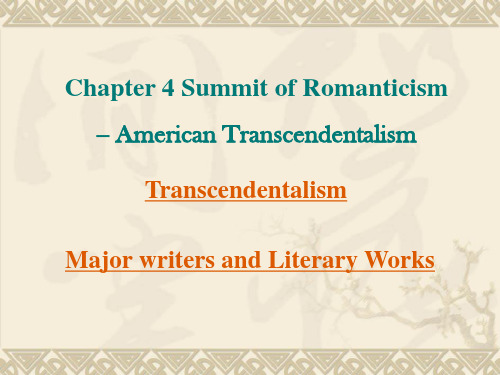
Transcendentalism
A broad, philosophical movement in New England during the Romantic era (peaking between 1835 and 1845). Appeared in 1830, marked the maturity of American romanticism and the first renaissance in the American literary history. The term was derived from the Latin verb transcendere: to rise above, to pass beyond the limits. It stressed the role of divinity in nature and the individual’s intuition, and exalted feeling over reason.
2. Transcendentalism as a philosophy
A way of knowing (or epistemology ); Individuals can intuitively receive higher truths. The visible world, if intuited with imagination, offers endless clues about the invisible world whose truth stand eternally behind the factual world perceived by the senses.
New England Transcendentalism The phase of New England Transcendentalism is the summit of American Romanticism. It was, in essence, romanticism on Puritan soil. It was started by a group of intellectual and the literary men of the United States such as Emerson, Henry David Thoreau who were members of an informal club, i.e. the Transcendental Club in New England in the l830s.
Emerson-Transcendentalism常耀信-美国文学-超验主义.爱默生PPT课件

(a new way of looking at man)
•7
Features
nature is the symbol of spirit/the garment of the Oversoul
• Nature was alive, filled with God’s overwhelming presence. The physical world was a symbol of the spiritual.
• Spirit / Oversoul is the most important thing in the universe.
•It exists in nature and man alike and constituted the universe. •It is omnipresent (present everywhere) and omnipotent (able to do anything)
a. In Emerson's opinion, poets should function as preachers who gave directions to the mass. b. True poetry should serve as a moral purification c. The argument (or his thought or experience) should decide the form of the poem instead of traditional techniques.
•11
Transcendentalism: quotes
“Standing on the bare ground, -my head bathed by the blithe air, and uplifted into infinite space, -all mean egotism vanishes. I become a transparent eye-ball.”
《美国文学》课件The Scarlet letter1
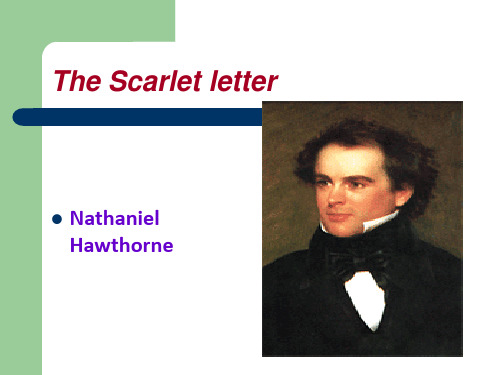
The Scarlet letter
I. Plot Overview (p.200-204) II. Character introduction and Analysis Hester Prynne: A young woman sent to the
colonies by her husband, the book’s protagonist and the wearer of the scarlet letter that gives the book its title. She is a symbol of the acknowledged sinner; one whose transgression has been identified and who makes appropriate, socio-religious atonement.
The Scarlet letter
Hester Prynne:
1) her strength of character. 2)honesty 3)a figure of compassion
The Scarlet letter
Dimmesdale , Dimmesdale is the unmarried pastor of Hester's congregation; he is also the father of Hester's daughter, Pearl. He is a symbol of the secret sinner; one who recognizes his transgression but keeps it hidden and secret, even to his own downfall.
美国文学简史常耀信版讲义1
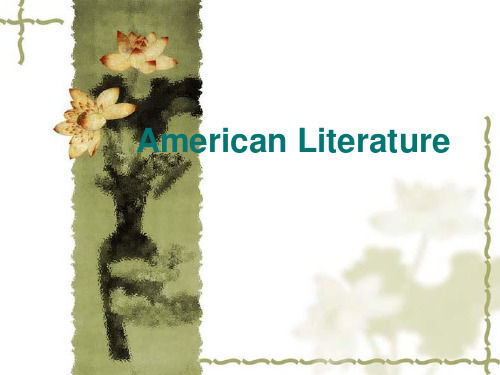
Hale Waihona Puke Historical Background
American literature begins with the orally transmitted myths, legends, tales, and lyrics (always songs) of Indian cultures. ---- no written literature The Indian’s contribution to America Indian words in everyday American English today such as “canoe”, “tobacco”, “potato”, “moccasin” 软鞋,鹿皮鞋, “raccoon” 浣熊 “persimmon” 柿子 “moose” 麋鹿 “tomahawk” 战斧 “totem” 图腾
Puritanism
Puritans was the name given in the 16th century to the more extreme Protestants(新 教徒,基督教徒) who thought the English Reformation (英国宗教改革)had not gone far enough. They wanted to purify their national church. In the 17th century many Puritans emigrated to the New World, where they sought to found a holy Commonwealth in New England. Puritanism remained the dominant cultural force in that area into the 19th century.
美国文学简史常耀信版Chapter_1and_2

Literary Scene
Historical background
The
first permanent English settlement in North America at James town, Virginia in 1607. In 1630 the puritans established the Massachusetts Bay Colony. Independent War (1776-1783); the foundation of a Federative bourgeois democratic republic—the United States of America.
Features of Puritanism
1) Predestination: God decided everything before things occurred. 2) Original sin: Human beings were born to be evil, and this original sin can be passed down from generation to generation. 3) Total depravity: Humanity’s utter corruption since the Fall. 4) Limited atonement: Only the ―elect‖ can be saved.
Hale Waihona Puke Puritanism: American Puritans
Puritans follow the ideas of John Calvin. Puritanism was influenced heavily by Calvinism. Calvinism refers to a comprehensive theological system, chiefly distinguished by its view of God and His relationship to man. The name of the system is derived by John Calvin’s surname. There are 5 major points of Calvinism. They are be remembered by the acronym: TULIP.
美国文学简史常耀信讲义

Three giants in American Realism: William Dean Howells Henry James Mark Twain
William Dean Howells
❖ William Dean Howells—the Dean of American Realism.
❖ 7. With regard to literary criticism, Howells felt that the literary critic should not try to impose arbitrary or subjective evaluations on books but should follow the detached scientist in accurate description, interpretation, and classification.
investigation of life ---“Realistic writers are like scientists.” ❖ 4. open-ending: ---Life is complex and cannot be fully understood. It leaves much room for readers to think by themselves. ❖ 5. concerned with social and psychological problems, revealing the frustrations of characters in an environment of sordidness and depravity
❖ 3. Characters should have solidity of specification and be real.
美国文学史常耀信版

美国文学史常耀信版美国文学Part 1. Colonial America浪漫主义American Romanticism(1815-1865)早期浪漫主义early romanticism——Irving欧文, Cooper库柏, Bryant布莱恩特先验主义transcendentalism and symbolic representation——Emerson 爱默森,Margaret Fuller玛格丽特福勒,Thoreau 梭罗三位重要的小说家——Hawthorne 霍桑,Melville 梅尔维尔,Poe 坡二位重要的诗人——Whitman 惠特曼,Dickinson 狄更生现实主义American Realism(1865-1914)带有地方色彩的写作local color writing——Mark Twain马克吐温现实主义literary realism——James 詹姆士,Howells 豪斯尔斯自然主义literary naturalism——Garland 加兰特,Grane 格雷恩,Frank Norris 弗兰克诺里斯,Jack London 杰克伦敦,Theodore Dreiser 西奥多德莱塞现代主义American Modernism(1914-1945)现代主义在欧洲American modernism in Europe——Gerturde Stein 格特鲁德斯坦因,Ezra Pound 艾兹拉庞德,Amy Lowell 艾米洛威尔,H.D.(Hilda Doolittle) 杜丽埃尔战时的现代派小说modern fiction between the wars——William Faulkner 威廉福克纳,Hemingway 海明威,Fitzgerald 费兹杰罗,Passos 帕索斯,Steinbeck 斯坦贝克现代派诗歌modern American poetry——T.S. Eliot 艾略特,Wallace Stevens 史蒂文斯,William Carols Williams 威廉姆斯,E.E.Cummings 卡明斯Thomas Paine托马斯•潘恩1737-1809 The Case of the Officers of Excise税务员问题;Common Sense常识;American Crisis美国危机;Rights of Man人的权利:Downfall of Despotism专制体制的崩溃;The Age of Reason理性时代Philip Freneau菲利普•弗伦诺1752-1832 The Rising Glory of America蒸蒸日上的美洲;The British Prison Ship英国囚船;To the Memory of the Brave Americans纪念美国勇士-----同类诗中最佳;The Wild Honeysuckle野生的金银花;The Indian Burying Ground印第安人殡葬地Jonathan Edwards The Freedom of the Will The Great Doctrine of Original Sin defended The Nature of True VirtueBenjamin Franklin本杰明•富兰克林1706-1790 A Modest Inquiry into the Nature and Necessity of a Paper Moneyoor Richard’s Almanack穷查理历书;The Way to Wealth致富之道;The Autobiography自传Part 2. American RomanticismWashington Irving华盛顿•欧文1783-1859 A History of New York纽约的历史-----美国人写的第一部诙谐文学杰作;The Sketch Book见闻札记The Legend of Sleepy Hollow睡谷的传说-----使之成为美国第一个获得国际声誉的作家;Bracebridge Hall布雷斯布里奇田庄;Talks of Travellers旅客谈;The Alhambra阿尔罕伯拉James Fenimore Cooper詹姆斯•费尼莫尔•库珀1789-1851 The Spy间谍;The Pilot领航者;The Littlepage Manuscripts利特佩奇的手稿;Leatherstocking Tales皮裹腿故事集:The Pioneer拓荒者;The Last of Mohicans最后的莫希干人;The Prairie大草原;The Pathfinder探路者;The Deerslayer杀鹿者Part 3.New England TranscendentalismRalf Waldo Emerson拉尔夫•沃尔多•爱默生1803-1882 Essays散文集:Nature论自然-----新英格兰超验主义者的宣言书;The American Scholar论美国学者;Divinity;The Oversoul论超灵;Self-reliance论自立;The Transcendentalist超验主义者;Representative Men代表人物;English Traits英国人的特征;School Address神学院演说Concord Hymn康考德颂;The Rhodo杜鹃花;The Humble Bee野蜂;Days日子-首开自由诗之先河Henry David Threau亨利•大卫•梭罗1817-1862 Wadden,or Life in the Woods华腾湖或林中生活;Resistance to Civil Government/Civil Disobedience抵制公民政府;A Week on the Concord and Merrimack Rivers Henry Wadsworth Longfellow亨利•沃兹沃思•朗费罗1807-1882 The Song of Hiawatha海华沙之歌----美国人写的第一部印第安人史诗;Voices of the Night夜吟;Ballads and Other Poens民谣及其他诗;Belfry of Bruges and Other Poems布鲁茨的钟楼及其他诗;Tales of a Wayside Inn路边客栈的故事---诗集:An April Day四月的一天/A Psalm of Life人生礼物/Paul Revere’s Ride保罗•里维尔的夜奔;Evangeline伊凡吉琳;The Courtship of Miles Standish迈尔斯•斯坦迪什的求婚----叙事长诗;Poems on Slavery奴役篇---反蓄奴组诗Nathaniel Hawthorne纳撒尼尔•霍桑1804-1864Twice-told Tales尽人皆知的故事;Mosses from an Old Manse古屋青苔:Young Goodman Brown年轻的古德曼•布朗;The Scarlet Letter红字;The House of the Seven Gables有七个尖角阁的房子--------心理若们罗曼史;The Blithedale Romance福谷传奇;The Marble Faun玉石雕像Herman Melville赫尔曼•梅尔维尔1819-1891 Moby Dick/The White Whale莫比•迪克/白鲸;Typee泰比;Omoo奥穆;Mardi玛地;Redburn雷得本;White Jacket白外衣ierre皮尔埃iazza广场故事;Billy Budd比利•巴德Walt Whitman沃尔特•惠特曼1819-1892 Leaves of Grass草叶集:Song of the Broad-Axe阔斧之歌;I hear America Singing我听见美洲在歌唱;When Lilacs Lost in the Dooryard Bloom’d小院丁香花开时;Democratic Vistas民主的前景;The Tramp and Strike Question流浪汉和罢工问题;Song of Myself自我之歌Emily Dickinson埃米莉•迪金森1830-1886 The Poems of Emily Dichenson埃米莉•迪金森诗集-----“Tell all the truth and tell it slant”迂回曲折的,玄学的Edgar Allan Poe埃德加•爱伦•坡1809-1849(以诗为诗;永为世人共赏的伟大抒情诗人-----叶芝)Tales of the Grotesque and Arabesque怪诞奇异故事集;Tales故事集;The Fall of the House of Usher厄舍古屋的倒塌;Ligeia莱琪儿;Annabel Lee安娜贝尔•李-----歌特风格;首开近代侦探小说先河,又是法国象征主义运动的源头Tamerlane and Other Poems帖木儿和其他诗;Al Araaf,Tamerlane and Minor Poems艾尔•阿拉夫,帖木儿和其他诗;The Raven and Other Poems乌鸦及其他诗:The Raven乌鸦;The City in the Sea海城;Israfel 伊斯拉菲尔;To Hellen致海伦Harriet Beecher Stowe哈丽特•比彻•斯托1811-1896 Uncle Tom’s Cabin汤姆叔叔的小屋;A Tale of the Great Dismal Swamp德雷德阴暗大沼地的故事片;The Minister’s Wooing牧师的求婚;The Pearl of Orr’s Island 奥尔岛的珍珠;Oldtown Folks老城的人们Part 4. The age of RealismWilliam Dean Howells 威廉•狄恩•豪威尔斯1837-1920 The Rise of Silas Lapham赛拉斯•拉帕姆的发迹;A Modern Instance现代婚姻; A Hazard of Now Fortunes时来运转;A Traveller from Altruia从利他国来的旅客;Through the Eye of the Needle透过针眼----乌托邦小说;Criticism and Fiction;Novel-Writing and Novel-Reading 小说创作与小说阅读23、Henry James享利•詹姆斯1843-1916 小说:Daisy Miller苔瑟•米乐;The Portrait of a Lady贵妇人画像;The Bostonians波士顿人;The Real Thing and Other Tales真货色及其他故事;The Wings of the Dove鸽翼;The Ambassadors大使;The Golden Bowl金碗评论集:French Poets and Novelists法国诗人和小说家;Hawthorne霍桑;Partial Portraits不完全的画像;Notes and Reviews札记与评论;Art of Fiction and Other Essays小说艺术Part 5. Local ColorismMark Twain马克•吐温(Samuel Longhorne Clemens)---美国文学的一大里程碑The Celebrated Jumping Frog of Calaveras County加拉维拉县有名的跳蛙;The Innocent’s Abroad傻瓜出国记;The Gilded Age镀金时代;The Adventures of Tom Sawyer汤姆•索耶历险记;The Prince and the Pauper王子与贫儿;The Adventures of Huckleberry Finn哈克贝利•费恩历险记;A Connecticut Yankee in King Arthur’s Court亚瑟王宫中的美国佬;The Tragedy of Pudd’nhead Wilson傻瓜威尔逊;Personal Recollections of Joan of Arc冉•达克;The Man That Corrupted Hadleyburg败坏哈德莱堡的人How to Tell a Story怎样讲故事---对美国早期幽默文学的总结Part 6. American NaturalismStephen Crane斯蒂芬•克莱恩1871-1900 Magic:A Girl of the Streets街头女郎梅姬(美国文学史上首次站在同情立场上描写受辱妇女的悲惨命运);The Red Badge of Courage红色英勇勋章;The Open Boat小划子;The Bride Comes to Yellow Sky新娘来到黄天镇Frank Norris弗兰克•诺里斯1870-1902 Moran of the Lady Letty茱蒂夫人号上的莫兰(romantic);Mc-Teague麦克提格(naturalistic);The Epic of the Wheat(realistic)小麦诗史(The Octopus章鱼,The Pit小麦交易所);A Deal in Wheat and Other Stories of the Old and New West小麦交易所及其他新老西部故事Theodore Dreiser西奥多•德莱塞1871-1945 Sister Carrie嘉莉姐妹;Jennie Gerhardt珍妮姑娘;Trilogy of Desire欲望三部曲(Financer金融家,The Titan巨人,The Stoic);An American Tragedy美国的悲剧(被称为美国最伟大的小说);Nigger Jeff黑人杰弗Edwin Arlington Robinson鲁宾逊1869-1935 Captain Craig克雷格上尉---诗体小说;The Town Down the River河上的城镇;The Man Against the Sky衬托着天空的人;Avon’s Harvest沃冯的收成;Collected Poems诗集40、Jack London杰克•伦敦1876-1916 The Son of the Wolf狼之子,The Call of the Wild野性的呼唤;The Sea-wolf海狼;White Fang白獠牙;The People of the Abyss深渊中的人们;The Iron Heel铁蹄;Marti Eden马丁•伊登;How I become a Socialist我怎样成为社会党人;The War of the Classes阶级之间的战争;What Life Means to Me 生命对我意味着什么;Revolution革命;Love of Life热爱生命;The Mexican墨西哥人;Under the Deck Awings在甲板的天蓬下Upton Sinclair厄普顿•辛克莱尔1878-1968 Spring and Harvest春天与收获;The Jungle屠场(揭发黑幕运动的代表作家);King Coal煤炭大王;Oil石油;Boston波士顿;Dragon’s Teeth龙齿Part 7. The 1920sImagism Ezra Pound艾兹拉•庞德1885-1972 The Spirit of Romance罗曼司精神;The Anthology Des Imagistes意像派诗选;Cathay华夏(英译中国诗);Literary Essays文学论;Hugh Swlwyn Mauberley;A Few Don’ts by Imagiste意像派戒条;Personage面具;Polite Essays文雅集;The Cantos of Ezra Pound庞德诗章(109首及8首未完成稿)Thomas Stearns Eliot托马斯•艾略特1888-1965 Prufrock and Other Observations普罗夫洛克(荒原意识);The Waste Land荒原(The Burial of the Dead死者的葬礼;A Game of Chess弈棋;The Fire Sermon火诫;Death by Water水边之死;What the Thunder Said雷电之言);名诗:Ash Wednesday圣灰星期三;Four Quarters四个四重奏诗剧:Murder in the Cathedral大教堂谋杀案;Family Reunion大团圆;Cocktail Party鸡尾酒会Wallace Stevens华莱士•史蒂文斯1879-1955 Harmonium风琴;The Man With the Blue Guitar弹蓝吉他的人;Notes Toward a Supreme Fiction关于最高虚构的札记(Peter Quince at the Clavier彼得•昆斯弹风琴;Sunday Morning礼拜天早晨);The Auroras of Autumn秋天的晨曦;Collected Poems诗集。
常耀信美国文学讲义PPT课件

American poetry experimenting
The new age demanded proper literary
expression. Between 1912 and 1922 there came a great poetry boom in which about 1000 poets published over 1000 volumes of poetry. Indeed, to express the modern spirit, the sense of fragmentation and dislocation. Affected by the postwar disillusionment and loss of faith, the poets employ meaningless destruction of young lives in the war and the bankruptcy of the rotten civilization as themes. America has become “spiritual wasteland”.
ChapterFive
The Modern Period
Section 1 The 1920s Introduction The 1920s is a flowering period of American literature. It is considered “the second renaissance” of American literature. The nicknames for this period: (1) Roaring 20s – comfort (2) Dollar Decade – rich (3) Jazz Age – Jazz music
- 1、下载文档前请自行甄别文档内容的完整性,平台不提供额外的编辑、内容补充、找答案等附加服务。
- 2、"仅部分预览"的文档,不可在线预览部分如存在完整性等问题,可反馈申请退款(可完整预览的文档不适用该条件!)。
- 3、如文档侵犯您的权益,请联系客服反馈,我们会尽快为您处理(人工客服工作时间:9:00-18:30)。
? Local color stories tend to be concerned with the character of the district or region rather than with the individual: characters may become character types, sometimes quaint or stereotypical. The characters are marked by their adherence to the old ways, by dialect, and by particular personality traits central to the region. In women's local color fiction, the heroines are often unmarried women or young girls.
? All regions of the country celebrated themselves in writing influenced by local color. Some of it included social protest, especially toward the end of the century, when social inequality and economic hardship were particularly pressing issues. Racial injustice and inequality between the sexes appear in the works of southern writers such as George Washington Cable (1844-1925) and Kate Chopin (1851-1904), whose powerful novels set in Cajun/French Louisiana transcend the local color label.
? A variation of this genre is the "plantation tradition" fiction of Thomas Nelson Page and others.
Characteristics Setting
? The emphasis is frequently on nature and the limitations it imposes; settings are frequently remote and inaccessible. The setting is integral to the story and may sometimes become a character in itself.
? Features of local colorism
Local colorism
Defininition
? Local color or regional literature is fiction and poetry that focuses on the characters, dialect, customs, topography, and other features particular to a specific region. Influenced by Southwestern and Down East humor, between the Civil War and the end of the nineteenth century this mode of writing became dominant in American literature.
Features of local colorism
? Characteristics Setting
? Characters
? Narrator
? Plots
? Themes
General critical overview
? Many critics have argued that this literary movement contributed to the reunification of the country after the Civil War and to the building of national identity toward the end of the nineteenth century. According to Brodhead, "regionalism's representation of vernacular cultures as enclaves of tradition insulated from larger cultural contact is palpably a fiction . . . its public function was not just to mourn lost cultures but to purvey a certain story of contemporary cultures and of the relations among them" (121).
Chapter 4
The Age of Realism (2)
Local Colorism
Mark Twain
Contents
? Local colorism
? Mark Twain
Assignments this Chapter
? Define the term: local colorism, classic plot analysis
? Simply give the story the classic plot analysis
? Answer the three questions from the Selected Readings on p 72.
Local colorism
? Definition
? Its representatives
? As the first great success in the local colorist school, Harte for a brief time was perhaps the best-known writer in America -- such was the appeal of his romantic version of the gun gun-slinging West. Outwardly realistic, he was one of the first to introduce low-life characters -- cunning gamblers, gaudy prostitutes, and uncouth robbers -- into serious literary works.
? In chronicling the nation's stories about its regions and mythical origins, local color fiction through its presence--and, later, its absence--contributed to the narrative of unified nationhood that late nineteenth-century America sought to construct.
? Hamlin Garland (p131)
? Several women writers are remembered for their fine depictions of New England: Mary Wilkins Freeman (1852-1930), Harriet Beecher Stowe (1811-1896), and especially Sarah Orne Jewett (1849-1909). Jewett's originality, exact observation of her Maine characters and setting, and sensitive style are best seen in her fine story "The White Heron" in Country of the Pointed Firs (1896). Harriet Beecher Stowe's local color works, especially The Pearl of Orr's Island (1862), depicting humble Maine fishing communities, greatly influenced Jewett.
? What are the features of Mark Twain’s writings?
? Tell the differences among Howells, Henry James and Mark Twain in writing themes and in writing technique
Themes
? Many local color stories share an antipathy to change and a certain degree of nostalgia for an always-past golden age. A celebration of community and acceptance in the face of adversity characterizes women's local color fiction. Thematic tension or conflict between urban ways and old-fashioned rural values is often symbolized by the intrusion of an outsider or interloper who seeks something from the community.
